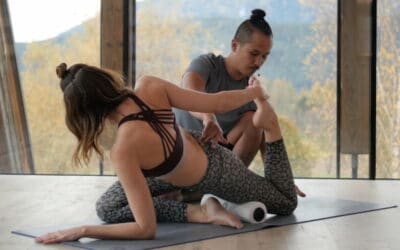To warm up or not to warm up – that’s the question many yoga teachers have when planning their next yoga class. But what does warm-up actually mean? And what benefits does it have, if any? And last but not least: How do you create an effective and beneficial yoga warm-up sequence for your practice?
Warming up simply means preparing the body to perform physical activity efficiently and without risk of injury. Think of an old car that you’re trying to start on a freezing winter morning. It will probably stutter and sputter until the engine finally dies. The same happens to the body: Without any warm-up exercises, the body will perform poorly and be at increased risk of injury.
Apart from that, a well-designed yoga warm-up sequence has an additional purpose: It helps to connect with the breath and prepares the mind to be calm and focused. A distracted mind prevents practitioners from paying attention to their body as it sends out signals of discomfort – which, if ignored, may eventually lead to injury.
Let’s look at the following questions in detail:

To warm up or not to warm up – that’s the question. Photograph on Unsplash.
1. Do I Need to Warm up for my Yoga Practice?
1.1. What’s the Purpose of Warming Up?
It seems to be common knowledge that we need to warm up our muscles when it comes to sports in order to put in our best performance and avoid injury. Most people will probably think of more or less intense stretching exercises to prepare the body for the activity to come. But when it comes to yoga, it may sound a bit superfluous to stretch for a practice which in itself consists of various stretching exercises.
However, according to a study conducted by the Centers for Disease Control and Prevention, “warming up, which typically means raising the body temperature enough to send the blood flowing through the muscles, requires more intense activity than stretching”.
In fact, the long-known practice of warming up the body by stretching has now been reversed. Instead, you need to warm up in order to stretch. In other words: It’s not a good idea to stretch a cold muscle. It’s a fact that muscles perform better when they’re warm. It’s just the form of the warm-up routine and the degree of its intensity that can vary depending on the activities ahead.
This is why a yoga warm-up sequence should pursue different aims than stretching the muscles. It should rather be intended to prepare the body for more intense yoga practices by performing only gentle stretches and smaller versions of the poses that are to come. This means that you should put the muscles through the functional range of motion that you will be using later, but at a slower pace.
1.2. How Can I Warm Up the Body for Yoga?
Therefore, a good yoga teacher should include some adequate basic yoga warm-up poses into their class plan. As mentioned before, such warm-up practice can take various forms and depends on the entire class design and the overall purpose of the yoga class.
One common approach is to start with a few rounds of Sun Salutations (Surya Namaskar), as you can practice in our Yin & Yang for Lower Hips and Spine. This is best practice for more dynamic yoga classes such as Vinyasa yoga or Inside Flow, which mostly include dynamic stretches requiring large range of motion movement and muscular effort.
The more intense the class the more physically demanding it is on the muscles and they will therefore need more preparation. That’s where a well-rounded yoga warm-up sequence consisting of (variations of) Sun Salutations, mobility exercises and other yoga warm-up poses can be really beneficial.
Warm up with Sun Salutations with David Lurey & Mirjam Wagner on TINT.
1.3. Can Warming Up for Yoga Be Counterproductive?
Yoga styles that mostly consist of more static poses, such as Yin yoga and other restorative yoga practices, do not require very intense warm-up exercises.
This is especially true if you and your students already had a few sessions together and you both know how their bodies respond. In such cases, warming up the body too much can even be counterproductive, as this will create heat in a practice that is intended slow and cool the body down.
Another factor to keep in mind is the time of the day and year. In the morning, the body is usually stiff and mobility is decreased. The same goes for cold winter days where muscles tend to be tighter due to the low temperatures. This is when your students may need a longer yoga warm-up sequence to get their bodies ready.
If you find yourself in the situation that you have to teach a yoga class, but have no time to prepare it, have a look at our Yoga Class Plans collection that offers ready-made class plans for different levels and with different topics. And it also contains a yoga warm-up session.
2. What Are the Benefits of Yoga Warm-Up Poses?
So, we agree that warming up the body, i.e. preparing it for the activities to come, is essential to your yoga practice. Let’s have a look at some of the most important benefits of yoga warm-up poses in detail.
1. Yoga Warm-Up Poses Stimulate Blood Circulation
One of the most important functions of yoga warm-up poses is the stimulation of the blood circulation throughout the entire body. As soon as the muscles start contracting, the heart rate rises. As a result, blood circulation increases, bringing important fuels such as oxygen to the muscle cells. The cells need these fuels to continuously work and contract.
Apart from that, a warm-up practice gives the blood vessels in the muscles time to expand, which increases the blood flow and releases more oxygen into the muscles. Lack of oxygen in the muscles inhibits their performance and decreases strength and endurance. On the other hand, the risk of injury and muscle soreness increases.
2. Yoga Warm-Up Poses Help Circulate the Synovial Fluid
Adequate yoga warm-up poses can also stimulate the circulation of synovial fluid into the joints. Synovial fluid is a thick fluid by the synovial membrane in the joint cavities and serves to protect and lubricate the joint. It also transports nutrients to those joint tissues that have no direct blood supply.
This means, when you move your joints, the cartilage soaks up the synovial fluid inside the joint like a sponge and draws more water and nutrients into the tissues.
This is why moving a joint through its full range of motion is considered to be the best way to activate the production of synovial fluid and increase the flow of nutrients into the joint tissue.
Apart from that, it also encourages the release of waste products out of the tissue through the synovial membrane.
3. Yoga Warm-Up Poses Encourage Conscious Breathing
As already mentioned above, starting your class with some yoga warm-up poses can help your students to connect with their breath. Conscious breathing during muscle contraction and release stimulates circulation and provides the muscles with fresh oxygen.
In addition, relaxed and deep breathing can help to calm the mind and release tension in the muscles. As a result, the muscles can perform more efficiently when we are breathing without excess tension.
This effect is even enhanced by diaphragmatic, or abdominal, breathing instead of breathing into the upper chest. This is why breathing exercises, called pranayama,can be an excellent way to begin your yoga warm-up routine.
4. Yoga Warm-Up Poses Can Enhance Concentration
The warm-up practice can also serve to focus attention and enhance concentration. This is because this part of your yoga class is a good time to invite your students to feel and listen into their bodies in order to notice and evaluate any physical and mental tensions they may be holding.
Be aware that most students will be rushing into your class straight from work or after having taken care of their family back home or having dealt with some other everyday-life issues. They will probably need some time to let go of this tumult and to arrive on the mat – not only physically but also mentally.
Therefore, a yoga warm-up sequence should not only serve to get the body ready for the physical activities to be performed in class, but also to prepare the mind and to coordinate body and mind to ensure that your students will receive the maximum benefits from the yoga practice.
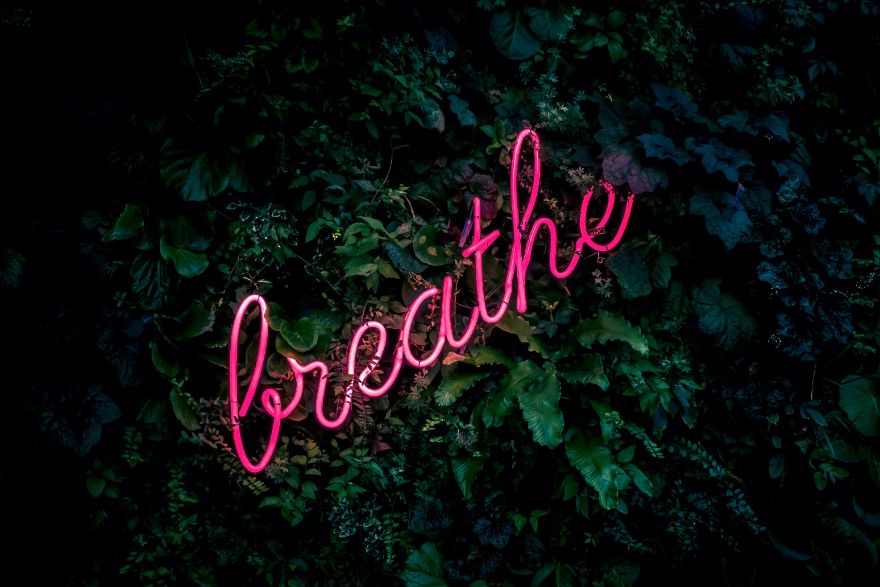
A yoga warm-up routine helps to improve breathing and concentration. Photograph by Fabian Møller on Unsplash.
To sum up, an effective yoga warm-up sequence should:
- Activate all major muscle groups to warm up the muscles and stimulate blood circulation;
- Move all joints through their full range of motion in order to stimulate the circulation of the synovial fluid;
- Promote conscious breathing to increase the efficiency of the yoga practice and to help calm the mind; and
- Give students the opportunity to listen into their bodies and prepare their minds for the practice ahead.
If you’re looking for a great tool as a yoga teacher to make the most of your classes, check out our Yoga Class Plans collection, which provides your sample yoga class plans ready to use for your yoga class. The perfect tool if time is too short to prepare your class.
3. How Do I Create a Basic Yoga Warm-Up Sequence?
If you now think: ‘Okay, I know that warming up is important for my yoga class, but how do I create an adequate and efficient yoga warm-up sequence?’, don’t worry. There are numerous example warm-up practices on TINT such as the Foundations in Barbra Noh’s Therapeutic Alignment Immersion or the Flow Foundations in Duncan Wong’s Cross Core Fit Flow, which both are mainly intended to practice fundamental movements required for the subsequent sessions.
A yoga warm-up routine is great to set the foundations, as Duncan Wong does.
Another possibility to start a yoga class is by explaining and demonstrating some basic moves that build the foundation of the movements practiced throughout the class, such as Finlay Wilson does in his 7 Days of Flexibility program.
Get some inspiration for a yoga warm-up routine from Finlay Wilson.
David Lurey and Mirjam Wagner provide a nice and balanced Yin-&-Yang approach to warming up in their yoga program for Shoulders & Upper Spine.
If you start practicing in the morning, try Kat Fowler’s Wake-up Flow in her Revive program on TINT.
Start your morning yoga class with Kat Fowler’s warm-up routine.
And here is a detailed description of a short yoga warm-up sequence that you can use to prepare the body for more vigorous yoga classes since it moves a variety of joints through their full range of motion and particularly strengthens some specific areas of the body such as the shoulders and the core.
1. Cat and Cow
- Start in a table-top position and tuck the toes. Bring the attention to the thoracic spine rather than focusing in the lumbar spine.
- Round the thoracic spine by bringing the chin to the chest and moving the shoulder blades away from each other.
- Push the ground away with straight arms, round the back and close the ribcage. Keep the shoulder girdle strong and stable while you hold this position and continue breathing.
- On an exhalation, let the chest sink down and lift the chin up. Focus on the shoulder blades and bring them together.
- Repeat this Cat-and-Cow sequence a few times.


Start your yoga warm-up with a few rounds of Cat and Cow.
2. Extended Cat and Cow
- On an exhalation, let the chest sink down into Cow again.
- Lift one leg and straighten it backwards. Consider this leg as an extension of the curve in the spine. Let the chest sink deeper and engage the leg muscles.
- Round the back, bend the knee and bring it forward to the nose. Push the ground away and round the back as much as you can (and even a bit more). Let the shoulder blades move away from each other. Maintain this pose for some breaths.
- On an inhalation, straighten the leg again and push it backwards.
- On the next exhalation, place the knee down onto the yoga mat.
- Repeat this sequence on the other side and alternate between both sites a few times.


Continue your warm-up with an extended version of Cat and Cow.
3. Three-Legged Dog and Warrior 1 Sequence
- Return to a table-top position and tuck the toes again.
- Bring one knee to the nose again and at the same time straighten the other leg. Round the back and engage the leg muscles of the straight leg while at the same time moving the shoulders forward and away from the ground.
- Come into a Three-Legged Downward-Facing Dog and bring the armpit of the opposite site further to the front and square the hip so that both hip bones face the floor.
- On an exhalation, bend the extended knee and bring it to the opposite elbow.
- On the next inhalation, straighten the leg back again.
- Step the leg forward between your hands with an exhalation to come into Warrior 1. Increase your stance and inwardly rotate the thighs, lift the shoulders up and move the chest forward and up. Straighten the arms and move them into an outward rotation.
- Bend the back knee and twist the torso towards the bent knee for a twisted Warrior variation. Bring the arms shoulder high and stretch them out to the sides.
- Lower the back knee so that it is just a few centimeters above the ground. Push both feet towards each other while at the same time pulling both hands away from each other. Place the back hand onto the back thigh and lift the front arm up into the air.
- As a next step, slide the back hand further down the thigh towards the heel. Try to straighten the front leg as far as possible and hold this position for a few breaths.
- Come back into Downward-Facing Dog and then lower the knees down onto the mat for a table-top position.
- Repeat the same sequence on the on the other side and alternate between both sides a few times.
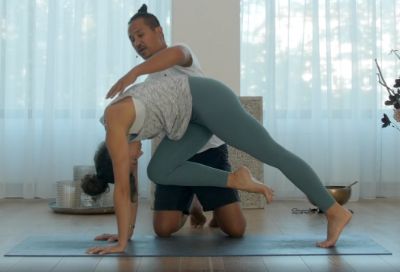
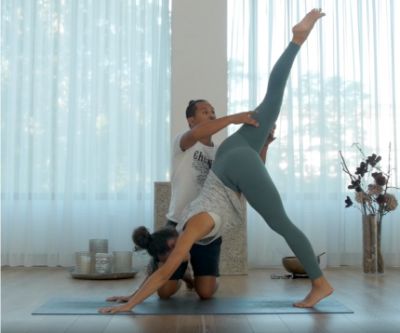
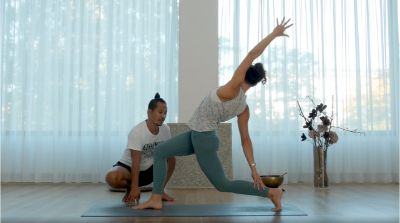
1. Bring the knee to the nose. 2. Straighten the leg for Three-Legged Dog. 3. Transition into a twisted Warrior 1.
4. Mini Vinyasa
- From the table-top position, transition into a Plank position with a wave-like movement. Tuck the tailbone and ripple through the vertebrae.
- Having arrived in Plank pose, tilt the pelvis forward, bend the knees and come into Downward-Facing Dog.
- Repeat this little sequence a few times and end in Downward-Facing Dog.
- From Downward-Facing Dog, come into Chaturanga. Then, place the knees down onto the mat and keep the buttocks sticking up.
- From this position, transition into Cobra pose in a wave-like movement. Having arrived in Cobra, push the ground away with the hands and lift the kneecaps off the floor.
- Move the armpits up and back and squeeze the elbows into the ribcage. Imagine you want to pull the ground towards you to open the chest. At the same time, imagine someone is pulling your head upward and your shoulder blades push the heart further forward.
- Return to Downward-Facing Dog and bend the knees. Tilt the hip forward and elevate the arm pits. Suck the lumbar spine inwards, i.e. the navel to the spine. Straighten the legs and hold this position for a few deep breaths to create more length in the spine. You actually want to feel and see the pulsation of the breath.
- Come back into table-top position and sit down on your heals to get ready for your yoga practice.



Transition into Cobra in a wave-like movement and return to Downward-Facing Dog.
4. What Does That Mean for My Yoga Practice?
So, the aim of a yoga warm-up routine is to (re-)establish elasticity and mobility in the muscles. One way to achieve this is by generating heat through movement and exploring the range of motion of the joints.
It also helps to (re-)connect with the breath and prepare body and mind for the upcoming yoga practice. A well-rounded yoga warm-up sequence is a useful tool make you and your students feel more agile and fresh.
The intensity of the yoga warm-up poses can vary and depends on the intensity of the class to come. Especially if the body is cold and stiff due to the time of the day or year, warming it up is definitely something you don’t want to miss.
In any way, there’s certainly no harm in doing some light movements to get things started. Even some simple warm-up routines to get the blood flowing and loosen up the joints can help and will certainly be appreciated by your students.
5. Watch the Video: Basic Warm Up with Young Ho Kim
Get inspiration for your yoga warm-up routine from Inside Yoga Alignment on TINT.


